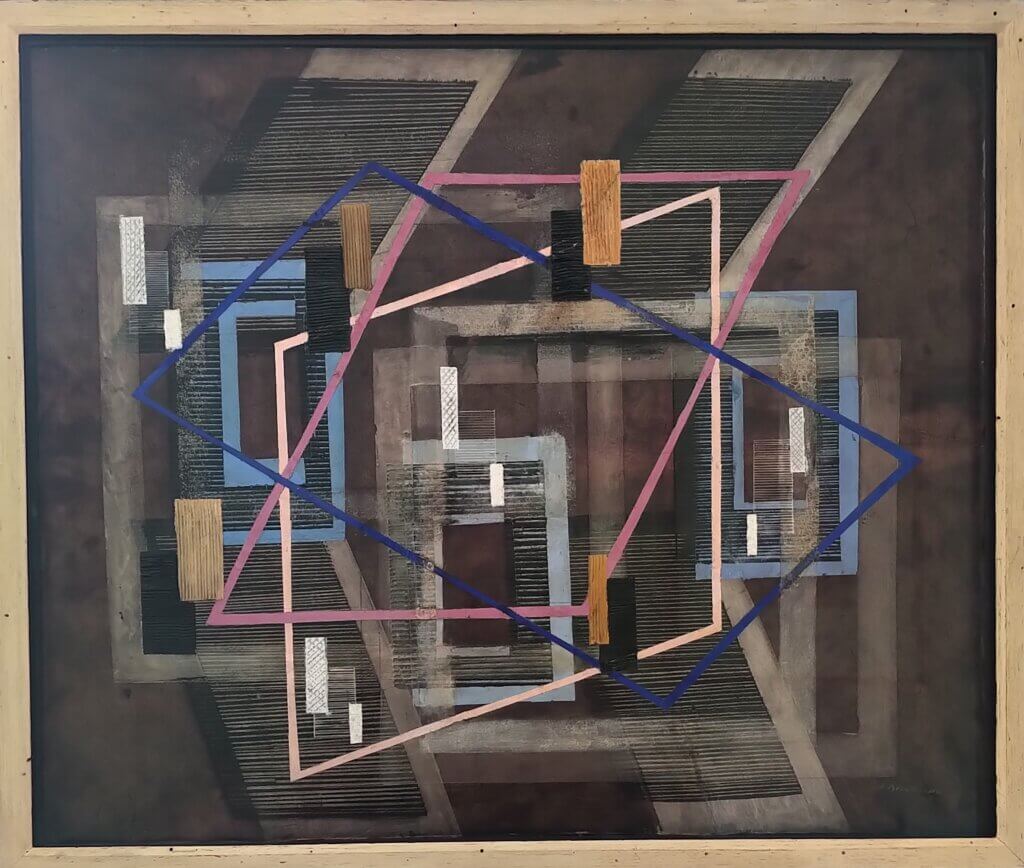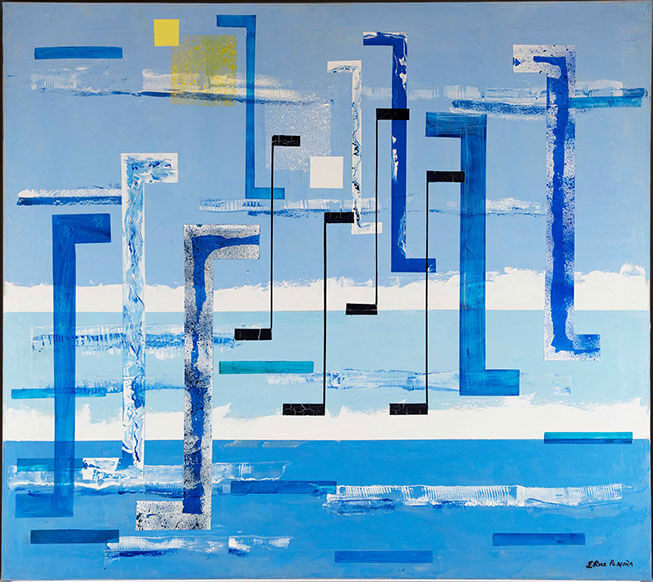CHRONOLOGY
1902
Irene M. Rice was born on August 5, in Chelsea, Mass., to Hilda Waterman Rice and Emmanuel Rice, a baker of Polish descent. A sister, Anita Rice, born 1906, became a Surrealist painter, later known as Juanita Rice Guccione.
c.1912
Family moves to western Massachusetts, living briefly in Pittsfield, settling in Great Barrington.
1914
Playing in field near home, artist undergoes experience that directs artistic development: watches sunlight refract in dewdrop on petal.
1915-21
Children return periodically to Boston to live with maternal grandmother during mother’s illnesses. Father dies circa 1918.
1922
Family moves to Brooklyn, N.Y.
1922-26
Completes commercial-secretarial course and assumes family’s support as stenographer.
1927-28
Attends evening classes at Art Students League, Manhattan. Begins three-year studies with Richard Lahey.
1929
Marries Humberto Pereira, commercial artist, painter, continuing to work as secretary.
1929-31
Studies with Jan Matulka at Art Students League.
1931-32
First trip to Europe, late summer 1931. Visits Academie Moderne, Paris, then travels to Switzerland, Italy and North Africa. In the Algerian Sahara undergoes a second experience that profoundly affects artistic development: “I learned that there were intense areas of feelings that could not be interpreted through objects … the impact of these mysterious forces left me stunned, shattered for many months.”

1932
Returns to New York via Cherbourg, France, in January. Spends summer painting in Provincetown, Mass. Begins painting semi-abstract ship paraphernalia.
1932-37
Paintings of this period depict “a feeling process of man in a machine world trying to establish his position–or rather my own position.”
1933
Has first solo show, at American Contemporary Arts (A.C.A.) Gallery, New York. Studies with Hans Hoffman at Art Student League for one month.
“Unmistakable abstractions are to be found at the A.C.A. Gallery, where I. Rice Pereira is having her first one-man show. Here is a young artist who paints boldly and effectively in her large canvases and with interesting color and whimsical humor in her smaller pictures. Although the marine subjects Miss Pereira chooses for her abstractions may not interest all, many will recognize her skill.” The New York Times, Jan. 22, 1933.
1934
Exhibits painting “Wharf Construction” in Second Biennial Exhibition, Whitney Museum of American Art, New York, which is called out by New York World-Telegram art critic Emily Genauer in a review for “skillful patterning.” Lives nearby in Greenwich Village at 18 East 13th Street.
1934-35
Executes series of wharf and boat paintings symbolizing, for her, the beginning of a voyage of discovery. Realizes she is frightened by machinery, begins to “dismantle” and “reorganize” machinery paintings in effort to re-establish footing in machine-world. Joins Public Works of Art Project.
1935-39
Plans industrial design curriculum in 1935 for the New York Laboratory School of Design of the Works Progress Administration’s Federal Arts Project. Instructs in design synthesis, painting and composition. Remains on faculty when in 1937 the Federation of Architects, Engineers, Chemists and Technicians takes over the laboratory. Resigns from Design Lab in October 1939. Works in WPA’s Easel Division, 1937-39, doing experimental work in 1939 in the new technical laboratory. Begins lifelong correspondence with scientists and manufacturers of chemical, glass, paint, plastic, and other materials. Colors now become vibrant, a process that will continue. Moves to 2 West 16th Street in 1936.
1937
Moves toward abstraction, painting “Six Black Squares,” but first calling it “Transfer Ticket”; it employs Chinese-like ideographs which the artist paints while singing with “the feeling that I was writing an ancient language that I could no longer read–I was writing my own ticket.” She joins the Easel Division of the Federal Art Project.
1938
Divorces Pereira. Has solo show at Howard University, Washington, DC. Does collage, superimposing actual ticket and newsprint headline entitled “Sing a New Song” on depictions of machinery. “I had transferred from the machine to the unknown white center,” Pereira wrote of this period in 1950, which she would often represent by bare canvas. From now on, she conceives of her eye as feeling rather than seeing. Period of abstraction begins.
1939
Paintings reflect absorption with dealing with shadows: how to make them real, how to project their implications. Has solo show at Julien Levy Gallery, New York. Lectures at Columbia University “New Materials and the Artist.”
1940-42
The Museum of Modern Art acquires the “Shadows with Painting” (1940), a radically inventive oil on glass over gouache on pencil and ink on cardboard and “Exploration with a Pencil” (1940). Begins work at Museum of Non-Objective Painting as museum assistant. Works there until 1942. Experiments intensely with such materials as mica, string, toy parts, glyptal resin, sand, tape, wood, plastic, glass, trapezoidal canvas and parchment, box and electrified frames. Works with glass. Begins to believe that “symbols are essences of the properties of space.”
Lectures with David Smith and Stuart Davis at United American Artists, and Brooklyn Art Center, Brooklyn Museum “Cubism and Abstract Art.”
1941
First paintings on parchment. Begins periodic summer trips to Nantucket, Mass., that continue through 1949. Sister Dorothy, to whom she will dedicate all her writings, dies of breast cancer in September.
1942
Marries George Wellington Brown, engineer. They share a fascination with materials and the relationship of science to art. Teaches design at Pratt Institute through January 1943. Moves to apartment-studio at 121 West 15th St., where she will remain until December 1970.
1943
Resigns from Pratt Institute when diagnosed with cancer. Undergoes radical mastectomy.
1944
Newark Museum purchases 1942 “Composition in White.” Solo show at Peggy Guggenheim’s Art of This Century Gallery, New York including 22 works.
“Miss Pereira knows more definitely than some of the other practitioners of the abstract what it is that she wants to do and how to do it.” Henry McBride, New York Sun.
“Precision of workmanship and also of design sets this exhibition ahead of almost anything we have seen…Miss Pereira, a delicate and slight young woman, who through illness nearly lost the use of her right arm last year and has done these paintings and a number of others in about 4 months since recovery, has the vision of an inventor and the manual control of a watchmaker.” Art Digest, 1944.
1946
Turns from painting on glass to translating the knowledge gained to larger works on canvas. Wins $500 award at prestigious Pepsi-Cola Third Annual Exhibition. Exhibits Fourteen Americans, curated by Dorothy Miller, at the Museum of Modern Art, New York. Included in U.S. Statement exhibit, Advancing American Art. Called “one of America’s leading abstractionists” by Elizabeth McCausland in Magazine of Art, December.
1947
Has solo show at San Francisco Museum of Art.
1948
Begins Jungian psychoanalysis. Has solo show at Barnett-Aden Gallery, Washington, DC.
“Her work has a geometrical precision not usually associated with her sex. Still young, she has made phenomenal technical progress since she showed here almost a decade ago.” Washington Post, January 9, 1949.
1949
Separates from George Brown. Spends autumn in Paris. Finds broad interest in her paintings on glass and ideas about optics. Back in Manhattan, undergoes third of life-changing experiences: interprets dream of a comet to mean that number represents psychic realities. ACA Gallery exhibit February 28-March 19.
“I. Rice Pereira is softening up a little bit. In her newest show at the A.C.A. Gallery, the old, pure abstractions, often painted on glass which were strikingly handsome experiments in the refraction of light, have been replaced by works that have undeniably lyrical, even a whimsical, approach.” The New York World, March 7, 1949
“Irene Rice-Pereira, magician-technician of non-objective painting, is holding one of the most fascinating exhibitions in her well-known career, at the A.C.A. Gallery. A gifted experimenter who exploits glass, plastic and parchment along with more conventional painting materials, Miss Pereira has long been noted for impeccable craftsmanship, lucid designing and purity of color, characteristics which dominate her current show. This year, however, her work is marked by more variety, new forms being noted along with a return to older ones.” The Art Digest, Judith Kaye Reed, March 1.
1950
Receives divorce from Brown. Spends summer working in London, briefly visiting Wiltshire, Lancashire. Moves to Salford, England, a suburb of Manchester, and marries George Reavey, Irish poet and translator of Dr. Zhivago, who teaches Russian grammar and literature at University of Manchester. Exhibits two paintings at Institute of Contemporary Arts, London. Writes “Crystal of the Rose,” restating childhood realization while watching dewdrop that God is the sun. Smog-shrouded Manchester oppresses her; her paintings of this period are the darkest of her career. Mark Rothko visits Pereira and Reavey in England.
1951
Returns to Manhattan. Teaches art at Ball State University, Muncie, IN., during summer. Reavey joins her in Manhattan in autumn. Joins the Durlacher Brothers Gallery. Publishes her first philosophical essay, “Light and the New Reality” in Palette.
1952
Solo exhibitions at Syracuse University, N.Y., and Dayton Art Institute, Ohio. Publishes “The Transformation of Nothing and the Paradox of Space.” Creates last glass paintings.

1953
Retrospective exhibition at Whitney Museum of American Art, Manhattan; exhibition travels to Des Moines Art Center, Dallas Museum of Fine Arts, San Francisco Museum of Art. Solo exhibitions at Vassar College, Poughkeepsie, N.Y., and Durlacher Bros., Manhattan. Spends time at the MacDowell Colony, New Hampshire. Makes first unsuccessful attempts to publish “Eastward Journey.”
1954-55
Paintings abandon parallelogrammatic, diagonal, trapezoidal structures and become bolder, larger. Leaves Reavey in 1955.
1956
Solo exhibitions, Corcoran Gallery, Washington, D.C., and Wellons Gallery, Manhattan. Publishes “The Nature of Space: A Metaphysical and Aesthetic Inquiry.”
1957
Publishes “The Lapis” a book containing watercolors and interpreting a dream concerning the fabled philosopher’s stone (republished in 1968 by Corcoran Gallery, Washington, D.C.).
1958
Joins Nordness Gallery, Manhattan; has first show there.
1959
Elected Life Fellow of the International Institute of Arts and Letters, Lindau-Bedensee, Germany. Publishes “Crystal of the Rose” with the Nordness Gallery, preface by Ranjee Shahani. Receives divorce from Reavey.
1960
First solo exhibition abroad at the Rome- New York Art Foundation and Galleria Obelisco, Rome, Italy. Travels twice to Italy. Visits Caresse Crosby’s Castle Roccasinibaldi.
1961
Publishes “The Poetics of the Form of Space, Light and the Infinite.” Begins lengthy correspondence with scientists involved in space explorations.
1962
Solo exhibition at Amel Gallery, Manhattan.
1963
Travels to Italy and stays at Castle Roccasinibaldi. Travels also to Switzerland and England. Received into Roman Catholic Church.
1964
Joins Galerie Internationale, Manhattan; has first show there.
1966
Publishes “The Transcendental Formal Logic of the Infinite.” Becomes regular contributor to the Literary Half-Yearly, published in Mysore, India.
1968
Hospitalized with severe breathing difficulties. Establishes I. Rice Pereira Foundation. The Corcoran Gallery of Art reprints “The Nature of Space: A Metaphysical and Aesthetic Inquiry.” Joins Kennedy Galleries. Interviewed for Oral History Collection, Archives of American Art, Washington, D.C.
1969
Publishes “The Poetics of the Form of Space, Light and the Infinite.” Receives honorary doctorate from L’Universite Libre (Asie), Karachi, Pakistan, and the International Federation of Scientific Research Societies of Europe, Asia, Africa and America. Splits with Kennedy Galleries.
1970
Travels to Paris, Madrid, and Brussels. Purchases apartment in Marbella, Spain. Visits clinic in Switzerland. Evicted in December from West 15th Street studio where she has lived for 31 years. Settles in Marbella.
1971
Dies January 11, 1971, in Marbella, Spain. Survived by mother and sister Juanita in New York, and brother James in Paris.
1974
Estate is administered by I. Rice Pereira Foundation, a charitable trust devoted to helping artists, writers and students, directed by her nephew, Djelloul Marbrook (1934-2024), who also owns copyright to her work.
